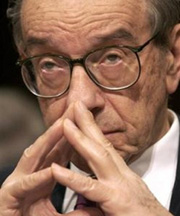 |
| In a file photo Federal Reserve Board Chairman Alan Greenspan ponders a question while testifying on Capitol Hill, Thursday, April 21, 2005 before the Senate Budget Committee. |
The Federal Reserve pushed borrowing costs to their highest point in nearly four years Tuesday in an attempt to make sure the combination of high energy prices and a solidly growing economy doesn't turn into a recipe for inflation.
Chairman Alan Greenspan and his colleagues lifted a key short-term rate, called the federal funds rate, by one-quarter percentage point to 3.50 percent. It marked the 10th increase of that size in the Fed's 14-month campaign to tighten credit.
In response, commercial banks began boosting their prime lending rates — used for many short-term consumer loans, including variable-rate credit cards and popular home equity lines of credit_ by a corresponding amount to 6.50 percent.
The increases left both the funds rate and the prime lending rates at their highest levels in nearly four years.
Fed policy-makers, in a brief statement accompanying their rate decision, had mostly good things to say about the economy.
They said that despite high energy prices, consumers and businesses are spending — important forces behind economic activity. And they noted that the job climate continues to improve.
But policy-makers made clear once again that fighting inflation — which currently doesn't appear to be a danger to the economy — remains a top mission. "Pressures on inflation have stayed elevated," they said. The Fed's previous statement, on June 30, used the same language.
Against thatbackdrop, the Fed stuck to its course of gradually raising rates to fend off inflation. It said future rate increases would be at "at a pace that is likely to be measured." Analysts view that phrase as meaning additional quarter-point increases at the Fed's next meeting, Sept. 20, as well as the year's last two meetings in November and December.
If that turns out to be the case, the funds rate — the interest banks charge each other onovernightloans — would climb to 4.25 percent by the end of this year. That would push the prime rate to 7.25 percent.
"The Fed is very comfortable with its strategy of slowly pushing rates higher," said Lynn Reaser, chief economist at Banc of America Capital Management. "It, however, believes we still have a ways to go before rates get to a level that will keep the economy growing but also hold inflation in check."
Reaser and some other economists believe the Fed may continue its steady rate raising into 2006.
(Agencies)
|
